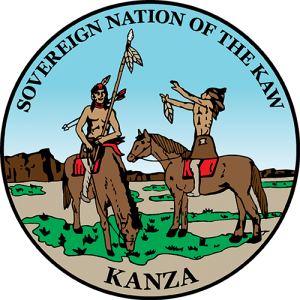Since Removal from Kansas in 1873
Passage of the Curtis Act in 1898 (named after Charles Curtis – United States Vice President under Hoover and a Kaw tribal member) put into law several far-reaching and particularly damaging clauses. These included (a) more authority to the Dawes Commission for the allotment of lands to individuals without permission of tribal governments, (b) power to the Secretary of the Interior to lease out tribal lands to whomever he saw fit, (c) ability of states and other entities to make towns and cities on lands vacated by tribes, with preference going to those who held land leases granted by the Secretary of the Interior (d) loss of power of tribal governments to issue individual Indian monies, and (e) abolition of tribal courts, with US courts assuming former tribal jurisdiction. Then, on July 1, 1902, a bona fide Act of Congress declared that the Kaw Tribe as a legal entity no longer existed. The 1902 Allotment obligated the tribe to cede 160 acres to the government for a school, agency headquarters, cemetery and an 80-acre town site named Washungah. Curtis and his three 1/16-blood Kaw children received about 1,625 acres of land. In 1884 a party of prominent Kaws made their way to the home of Mon-Zhon-Oka-She situated below the hills northwest of Pawhuska where they camped. The Kaws were Little Jim, Barkley Delano and Jim Pepper. They offered the Drum to the Osages and it was accepted by Mon-Zhon-O-Ka-She for his son Ben Mashunkashey who was then a small child. It has been told that the three Kaws spent the winter with Mon-Zhon-O-Ka-She. They made a fire, made a fireplace for those three that came. They brought their tradition, their drum, and their culture. They negotiated what would go on and how it would go on. The Osage tribe rewarded the Kaws handsomely for the Drum and held the first of the I’Loshka dances there. The dance is still being carried on today, called by the Osages In-Lon-Schka.
Last Full Blood Council 1916
In 1925 there was a dedication for the “Monument of the Unknown Kaw Indian” in Council Grove Kansas. Kaw members returned to Council Grove, Kansas.
In the early 1970s, the Army Corps of Engineers moved the Kaw Indian cemetery. Relocated in Newkirk, Oklahoma, the cemetery was moved to make way for Kaw Lake. At the same time, the Corps also relocated the Kaw Council House and the residents of the town of Washungah.
In June 1974 Robert Rankin, linguists from the University of Kansas worked with Maudie McCauley Rowe to preserve the language. He recorded her and developed a 3,500-word dictionary of Kaw language. Ralph Pepper and Walter Kekahbah were also interviewed.
Ralph Pepper files in court on behalf of 17 full-bloods to gain control of the Kaw tribe. The full-bloods won their case and a tribal election was ordered by a federal court order and held on November 22, 1974.
Maudie McCauley Rowe wanted to revive Kaw dances. The first Kaw dance was held after many years in 1977 at Shidler, Oklahoma. The dance was held in her son Elmer Clark’s back yard.
Centennial for the Osage
The Osage gave the I’Loshka Dance back to the tribe to carry on, in 1984. A ceremony was held in Pawhuska, Oklahoma inviting the Kaw tribe to the event. They acknowledged their district receiving the ceremonial drum from the tribe and unveiled a plaque noting the occasion. The plaque is located in Indian Camp at Pawhuska, Oklahoma.
Important Dates 1985 – Current
- Lena Sumner Lockhart, last full-blood Kaw woman, died on December 17, 1985. She had the woman’s drum and was the last woman drum keeper.
- In 1992 Bill Koch named one of his yachts after the Kaw Nation. Kanza was one of the yachts to be used in the American’s Cup race. Koch won the Cup that year racing against Dennis Conner.
- In November 1994 a contract was signed with sculptor, Mark Sampsel of Council Grove, Kansas to cast bronze busts of the last five full-bloods. The Executive Council wanted to honor these individuals. They were: Edgar Pepper, Jesse Mehojah Jr., William A. Mehojah Sr., Clyde G. Monroe and Johnnie R. McCauley. The busts are displayed today in the Kaw Museum. The busts of five Kaw Chiefs are also displayed in the museum.
- On August 5th, 1995 the Kaw Nation honored the last four Kaw Full Bloods. They were presented honor blankets during the dedication of the Kaw Museum. They were: Jesse Mehojah, William A. Mehojah, Clyde G. Monroe and Johnnie R. McCauley. An honor blanket identical to the one they received is hanging in the Kanza Museum today with their names embroidered on it.
- In 1999 the Kaw Language Project is funded and revival of the Kaw language began.
- The last Kaw full-blood, William A. Mehojah, died April 23, 2000, Easter morning, in Omaha, Nebraska.
- Over 100 bodies were discovered by the Kaw Nation’s Environmental Department at Washungah Bay. The bodies had been left during relocation of the cemetery in the early 70s. The Corps of Engineers was contacted. The tribe relocated the remaining bodies to the Kaw Cemetery in Newkirk, Oklahoma in October 2000.
- On August 20, 2011 Kaw Nation approved a new Ratified Constitution.
